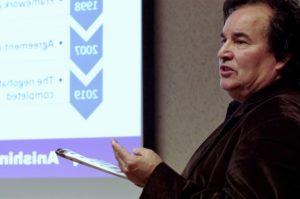Negotiator explores Anishinabek Nation Governance Agreement at Thunder Bay information session

By Rick Garrick
THUNDER BAY— A wide range of questions and concerns about the Anishinabek Nation Governance Agreement were addressed by Anishinabek Nation Governance Agreement Chief Negotiator Martin Bayer during a Jan. 18 information session in Thunder Bay.
“I thought the community members raised a lot of legitimate concerns in terms of the amount of information they want and are not receiving — I think those were well taken and understood,” says Bayer, a lawyer and Aundeck Omni Kaning citizen. “That is where they are at right now so that is important for them to say those things.”
One of the concerns brought up during the information session was that Fort William currently does not have a constitution and therefore does not qualify to vote to ratify the Anishinabek Nation Governance Agreement. A constitution, as well as a Band Council Resolution, are required in order for a First Nation to participate in the ratification vote.
“They would still get another kick at this [ratification vote] once they’ve done their constitution,” Bayer says. “There’s going to be other opportunities for people to vote later on as well when they’re ready.”
Bayer says there has been a varied response to the information sessions he has been delivering across Anishinabek Nation territory.
“It varies — some communities are really gung-ho, they’re well prepared for the vote,” Bayer says. “Other communities share some of the same kind of concerns that were shared here about wanting more information available to them. I think we can do a better job of that, of getting information to the people and explaining it to the people. The information is there, it’s just that I think people need to be led a bit better in terms of how to find it and then how to understand it.”
Bayer says there is information about the Anishinabek Nation Governance Agreement on the Anishinabek Nation website at: governancevote.ca. Information is also available at the First Nation band offices.
“This didn’t just start yesterday, this has been going on for 25 years now so a lot of information has been shared over the years,” Bayer says. “So it’s just a matter of trying to point them in the right direction so they’ll have a better sense of what the Agreement is about, and then maybe they’ll feel a little bit more comfortable about voting on the Agreement one way or the other.”
Bayer says 18 Anishinabek Nations are set to participate in the Anishinabek Nation Governance Agreement ratification vote from Feb. 1-29.
“Whether you agree with the [Anishinabek Nation Governance Agreement] or not, it’s important to have your say and to get out and vote,” Bayer says.
Eligible voters have three options to vote: mail-in ballots, in-person at a polling station, or electronically.
Bayer also spoke about the Anishinabek Nation Fiscal Agreement, a complementary agreement to the Anishinabek Nation Governance Agreement, during his presentation.
“It’s the companion agreement that deals with the money that is going to flow as part of the ratification of the Governance Agreement,” Bayer says. “It will recognize those funding arrangements and establish some of the processes in how the money will be delivered to the First Nations that ratify the Governance Agreement.”
Bayer says each First Nation that ratifies the Anishinabek Nation Governance Agreement will receive governance funding of a minimum of $1.7 million as well as one-time implementation funding of $548,000.

